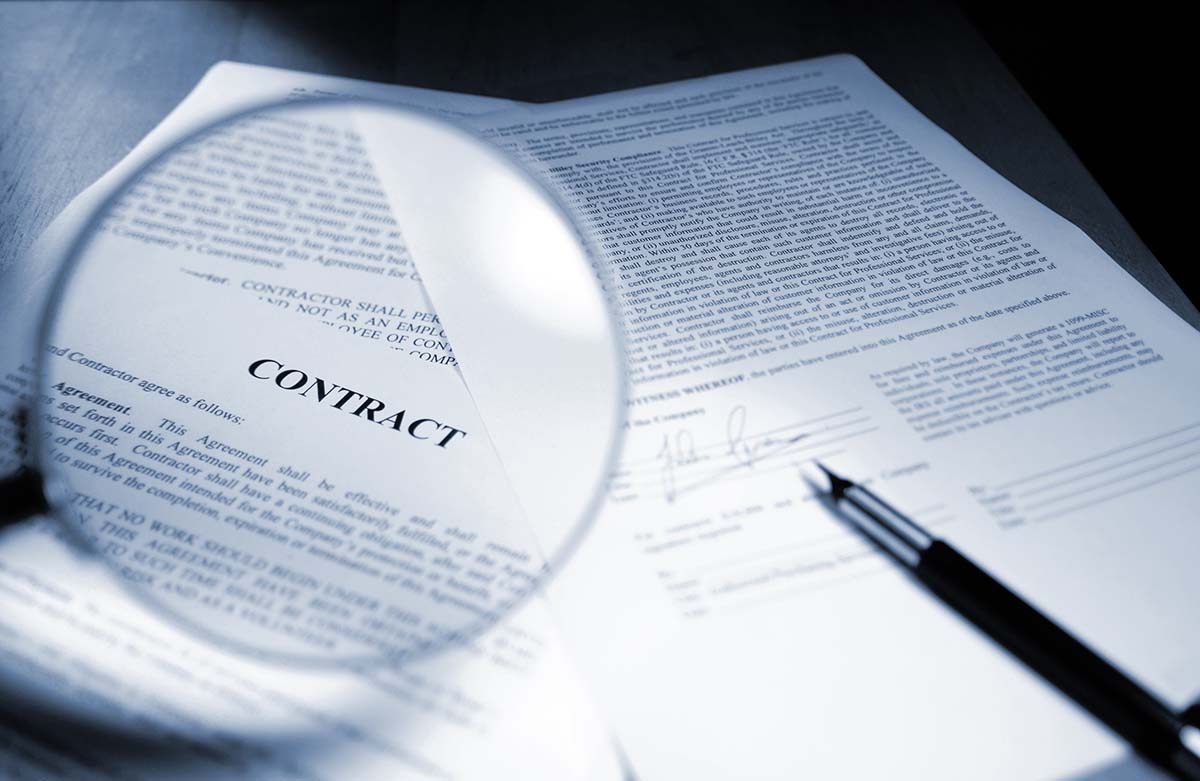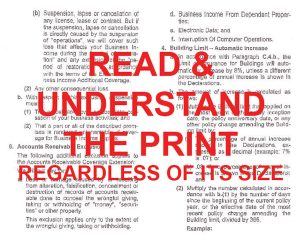
Read the Fine Print
Published on September 30, 2025They say the devil is in the details, and all too often those details are in the fine print. Meanwhile, we live in a highly litigious society, where law firms are constantly advertising their services — whether on TV or through other channels — eager to help you secure a monetary settlement for almost any perceived grievance. Worse, there are some law firms that shout out, “Even if it’s your fault, we will get you the compensation that you deserve.” What is infuriating is that all too often right and wrong, along with logic, ration and reason, seem not to matter much in these situations.
An Unfortunate Reality
For marinas, boatyards, yacht clubs and similar recreational boating facilities, these legal threats are an unfortunate reality. We often receive calls from “ambulance-chasing” lawyers seeking our assistance as industry experts. In most cases, we steer clear of such involvement unless there’s a significant policy or design issue that needs to be addressed. More often, our role is defending marinas against these typically frivolous claims.
The good news is that it’s possible to reduce liability, mitigate risks and protect your rights with some straightforward actions: mostly common sense and due diligence. However, in the daily rush of things, it’s easy for these precautions to get pushed aside.
Someone once said that lawyers are professionals we love to hate. They charge by the second, and their legal jargon is often a puzzle only they and their peers can solve. But despite their reputation, good lawyers do serve a vital role, protecting their clients by anticipating potential risks that others may overlook. Yes, it’s difficult to draft simple, concise agreements that cover all bases, but it’s certainly possible, and I’ve seen contracts that are clear, understandable and easy to navigate. Contracts shouldn’t require a magnifying glass to read or a lawyer to interpret.
When contracts are easy to understand, customers appreciate transparency, and it makes it much easier to resolve any issues that arise. Disputes can be settled quickly and efficiently, often without the involvement of lawyers at all.
Many of the issues with agreements stem from a lack of full transparency, poorly chosen words and/or a lack of information, and they often arise from differences in understanding of the meaning or assuming things that may be generic to one side but not to the other.
Customer Contracts
When it comes to marinas as the contract issuer, most agreements with customers typically fall into three main categories: work orders for service, in-season in-water or upland/dry sail/rack storage, or off-season/winter storage. For such agreements it is helpful to be explicit as to what is or is not in the fees quoted. For instance, some facilities separately meter utilities and charge for their usage. If not covered in the agreement, one way or the other, it can lead to a big, unappreciated surprise for the customers when they get the bill.
It is also important that your customer contracts spell out what the marina is or is not responsible for, including such things as storms, determining fault, etc. Having such a list can also help your customers know what their insurance should be covering.
We really do find that full transparency goes a long way, not only in channeling customers’ expectations, but also in building customer loyalty, and it helps soften the blow when rates are increased.
Insurance Policies
Have you ever read everything that’s in any of your insurance policies? I am convinced that those who have created them work for the medical profession in seeking to cure insomnia. Most jargon in insurance policies makes reading building codes seem easy. A good broker is important. Ask plenty of questions, and make sure you know what is and is not covered, just like what you should be trying to do with your customers.
Insurance is all about how much risk one is willing to undertake. What often happens, however, is that when a major problem occurs, such as an episodic storm, flood or fire, most that have gone through the process come away saying, “I wish I had known about that limit,” or, “Why was this not covered?” It comes as a rude awakening. Insurance is expensive and is built in layers by the insurance company for the various risks and amounts that are covered. A good broker can be very helpful walking through both the risks and the extents or limitations on coverage
Some policies include “full replacement costs” coverage that can exceed various limits of the policy, while other policies stop at the various limits. What is often overlooked is that many states require insurance companies to cover upgrades to meet current codes, even if it exceeds the limit of the policy. There are also other somewhat hard-to-find clauses that place limits in various circumstances.
Once you are done analyzing what you want in a policy and what you are able to pay, it is a good idea to send a letter to the insurance company with the aid of your broker, outlining what you believe is being covered and what is not. It goes a long way to clearing up potential ambiguities and false expectations on both sides.
One case in point involves three marinas in the same region hit hard by a hurricane, with the floats at all three facilities floating off the piles at the peak of the storm surge. All three marinas believed that the piles for their floating docks were covered, which proved to be the case, but with quite differing end results. One of the marinas replaced their piles exactly as they had been prior to the storm per the policy language for reimbursement covering the “cost of replacement to the pre-storm condition.” The second marina was able to

obtain reimbursement for replacing the piles at a much longer length, allowing both better embedment and height so the floats would not float off of the piles in future storms surges. In this case, the broker was instrumental in suggesting that it would be cost-effective in trying to prevent future losses. After all, the floats floating off of the piles not only damaged the piles but also the docks and boats still attached. The language in the policy was vague, and the broker was extremely helpful. The third marina operator got reimbursement for the piles as they initially were, but installed longer piles, paying the additional cost. Three marinas, three different brokers, three different insurance companies, three different outcomes.
With customers as well as outside contractors, it is essential that you require and obtain insurance certificates for at least general liability, naming your firm as an additional insured. Some companies and brokers are reluctant to do so, and some just prefer naming your company as a certificate holder. That may not be enough. Being named as an additional insured takes away all ambiguity of coverage. There should not be any cost associated with the same, as it is a standard practice in the industry. If you get resistance from either your broker or insurance carrier, then I would suggest that it is time for a change. Similarly, marinas should be requiring the same from the marina’s customers’ insurance carriers.
I am often amazed when reviewing the insurance certificates that marinas have on file to find that the marina is not even named as a certificate holder, let alone as an additional insured, and/or that the certificate or underlying insurance has expired, which is a recipe for future adversarial issues.
With respect to expirations, it is also strongly recommended that you create a reminder in your calendar for 60 days prior to the expiration date of the insurance policy. It is surprising the number of marinas that fail to do this, and missed payments can lead to all sorts of problems, particularly if there is an unfortunate event.
Codes and Regulations
Similar fine print issues are applicable when one is trying to undertake an expansion, renovation or totally new project. The various codes and regulations can be a nightmare and making sure that you understand what the requirements are as well as what future requirements are is important to prevent unforeseen expenses and concerns. A good consultant can can assist in explaining the various alternatives prior to applying, as well as guide both you, the client, and the agencies through the process and checking the boxes that need to be checked and not getting into those that do not need to be checked. It’s also important to pay attention to the fine print that will come with those permits.
When it’s time to hire contractors/suppliers to implement a project, it is also very important for both parties to understand what is expected. Often you will have drawings with notes. Very often the notes are abbreviated for space and complexity and make lots of assumptions. The problem is that not all are on the same page, even though all are using the same vocabulary. We advise, depending on the size and complexity of the project, that a written set of specifications be provided that not only sets forth what is to be constructed, but also how it is to be constructed. There are many technical issues that are easily interpreted differently from what is expected to what is desired.
One of the more technical sets of requirements has to do with mobility/barrier free access, which in the United States is the Americans with Disabilities Act. Simply stating on the drawings “comply with ADA” does make a contactor responsible, but does not necessarily guarantee adherence to the regulations, and one may not find out until a complaint is filed with the U.S. Justice Department.
Even on something as relatively straightforward as ordering new docks, it amazes me the details that too often get lost, such as what freeboard one desires for a floating dock, where one places the cleats or what type and thickness the decking, stringers and walers are to be. I have often heard from contractors that, “This is the way I have always done it,” but it may not be the way the marina desires it. Transparency and specificity lead to met expectations and help prevent misunderstandings.
The bottom line is that reading the fine print really is needed, and that making your contract documents very transparent and using simple language helps prevent lots of potential issues that often become litigious.
Dan Natchez, CMP, is president of DANIEL S. NATCHEZ and ASSOCIATES Inc. He can be contacted by phone at 1/914/698-5678, by WhatsApp at 1/914/381-1234, by email at dan.n@dsnainc.com or online at www.dsnainc.com.
| Categories | |
| Tags |





